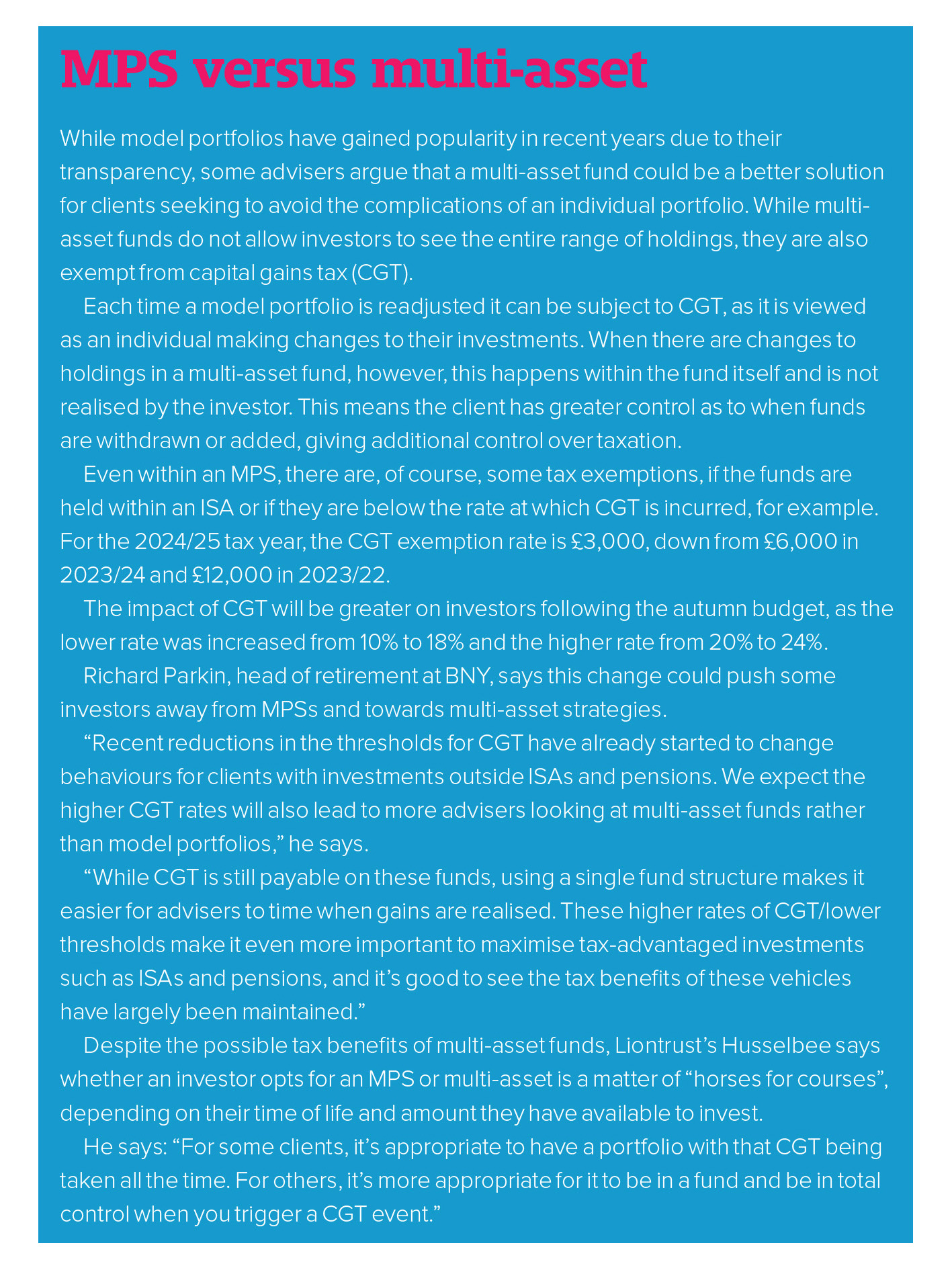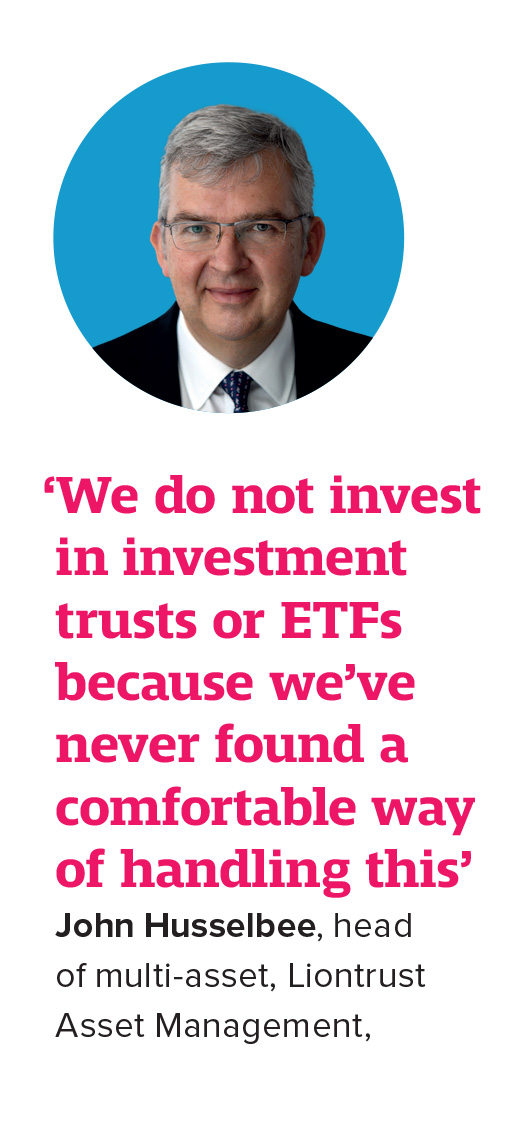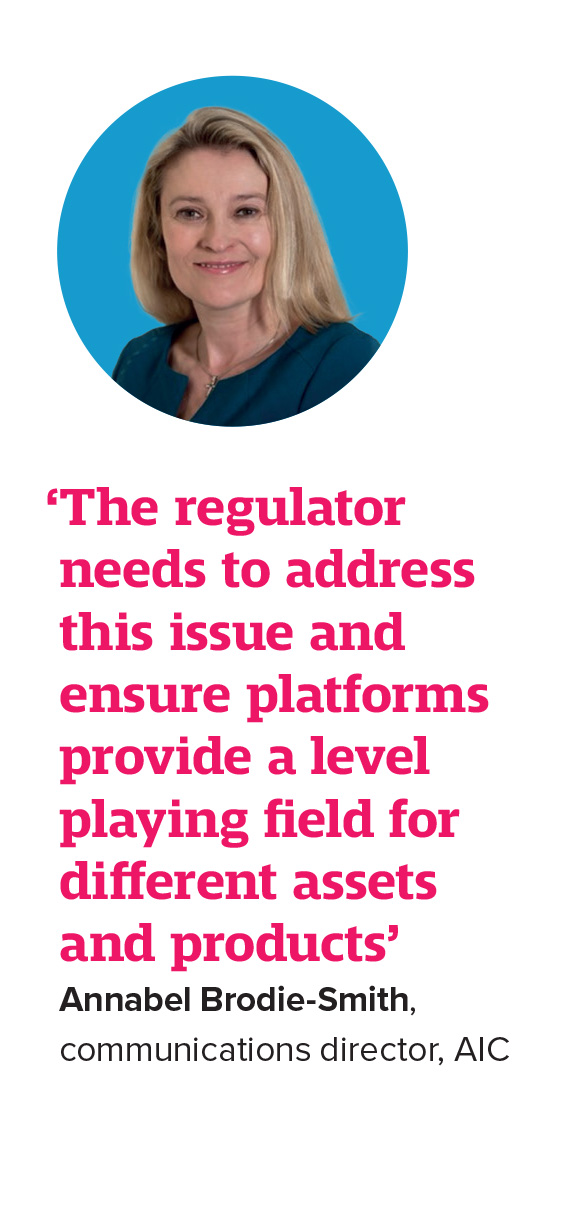Model portfolio services (MPS) have played an increasingly important role in the investment market during the past decade as firms seek new ways of offering consumers more transparent strategies. Yet while the vehicles gain popularity, some of the mechanics can clash with the more traditional parts of the asset management sector, creating friction when investors want to add exchange-traded funds (ETFs) and investment trusts (ITs) to their portfolio.
An MPS serves as a kind of ‘portfolio blueprint’ for investors wishing to opt in, but each client keeps their own pot of wealth invested rather than pooling it all into an individual fund. This means the end client can see exactly where their money is held at any one point. In contrast, a multi-asset or fund-of-fund would not allow for the same level of transparency.
However, the individual nature of the MPS comes with its own complexities. Each time a rebalancing occurs in the portfolio, the trades take place for each investor. This can cause complications in terms of capital gains tax. It also creates difficulties for investments in vehicles such as ITs and ETFs, which serve as individual trades as they are publically listed entities in their own right, rather than collectives with unlimited units available to investors.
Open-ended funds can be traded in partial shares, meaning if an investor cannot afford an entire share, they can purchase a percentage up to the fourth decimal point. But in the UK, ETFs and ITs must be purchased as a whole unit. When it comes to including the growing field of ETFs into an MPS, the investment must be large enough to cover the cost of the ETF, even if it makes up just a few percentage points of a portfolio.
Prices of ETFs span a wide range, with some reaching £900 a share. Many sit under £100. But if an MPS were to hold 1% of its portfolio in an ETF priced at £50, clients would have to hold at least £5,000 in the portfolio to be able to invest.
John Husselbee, head of multi-asset at Liontrust Asset Management, says the challenge comes from the nature of company law, which is applicable to ETFs and ITs because they are listed entities.
“We do not invest in investment trusts or ETFs because we’ve never found a comfortable way of handling this,” Husselbee explains.
“If my £100 client came along and I am selecting an investment trust, to get the exact weighting I need, 4% or something like that, I might have to buy 7.235 shares. If I go to the market and say to my trader, I’ll buy 7.235 shares, he’ll say, ‘No, you can’t. You can buy seven or eight shares, but you can’t buy any fractions of shares’.”

Using ETFs and ITs can also be an issue for investors when it comes to how platforms handle trading. Many platforms charge a flat fee for the trading of ETFs and ITs. Though this does not act as much of a hindrance if shares are traded as a group, as they would be for a multi-asset fund, for an MPS the charge is applied for each client individually.
This was a challenge met by Andrew Summers, CIO at Omnis Investments, as he created the Omnis Agility MPS, which holds 30% of the funds in ETFs in order to provide exposure to more specific areas of the market.
“They charge a lot of money per trade. If I were to buy £10,000 worth of an ETF that is £10 a trade, it doesn’t matter. But if I’m putting £100 a month into a regular savings plan, into my MPS, and with that £100 I want to buy 10 ETFs, I’m paying £10 just to buy £10 worth of ETFs. It’s a 100% charge, which is clearly not doable,” Summers explains.
“You need to get those charges reduced or removed, otherwise it doesn’t work. Some platforms will do it and some won’t. Some will do it for some clients but not for others. There’s a commercial conversation to be had. There are no ETF trading costs on any of our platforms. For us, that was a prerequisite.”
The points of friction between an MPS and funds that trade as companies have led some investment firms to get creative with the way they include them in strategies. And while open-ended funds present a much simpler set of criteria to use in an MPS, there are benefits of ETFs that, for Summers, make it worth the hassle, especially when he looks to invest in specific areas of the market where an open-ended fund is not readily available.
“It’s quite a significant undertaking to set up a whole fund structure for a trade that might last 18 months and might not actually have that much money in it. If we’re just going to execute a 1% trade in technology, it wouldn’t be scalable or economical,” he says.
“By allowing ourselves to have 30% of all of our different risk-profile portfolios in ETFs, there’s almost no limit to what you can buy. You can get really niche. We’re not going to go weird and wonderful, but we are going to look at a very specific trade.”
But for now, Summers has been forced to limit access to the Agility MPS to those who can invest at least £20,000. Otherwise, he says, there would simply not be enough money in the pot to make trades on the ETFs they want to hold due to the round number requirement.
Workarounds
Other firms have employed a series of workarounds to allow ETFs into the funds. 7IM has set up its own small ‘bank’ of ETFs that allows the funds themselves to facilitate the trades and allow for portions.
Sam Cole, senior platform relationship manager at 7IM, says: “Platforms can try and manage fractional shares, where the client gets a fraction of a share and the platform holds the remainder. However, this is complicated, requiring the platform to have a pool of fractional shares, and the client will be unlikely to be able to transfer that fraction of a share anywhere.

“Alternatively, the platform’s dealing system has to round up or down to the nearest whole share in order to execute the trade – usually up for sales and down for buys. This then typically results in a small amount of surplus cash held in the account as a result of that rounding process. This is the approach 7IM takes.”
AJ Bell has also used ETFs in its passive MPS range for several years, with some model portfolios predominantly constructed of ETFs. Terry McGivern, senior research analyst at AJ Bell, says the key to success in the process is to “recognise that the friction exists, and design the portfolio with that in mind”.
“While a lot of people would say you can’t do it, you can, you just have to be cognisant of the issues in advance. One of the things we pay attention to in our selection criteria when we’re picking a passive ETF to go in a model portfolio would be the unit price.
“Unit price is an irrelevant factor in an index fund as they’re fractional by nature. But with ETFs, in a model portfolio it matters greatly, because the unit price has to be taken in conjunction with the weighting in the portfolio.”
This has led McGivern to employ “stress-testing” for unit prices to see if the ETF will be able to be traded without significant issues if a portfolio rebalance is triggered. If the testing presents issues, McGivern will look to see if there are other funds that fit the model structure without creating trading concerns.
“In some instances it can mean you end up not selecting what would be your first choice in the market. We might favour a particular ETF, but then in the MPS we have to use an alternative ETF that rebalances more efficiently, or use an index fund instead,” he explains.
Liontrust’s Husselbee, who has opted not to include ETFs or ITs within his MPS offerings, but instead creates a substitution to match up his multi-asset funds as closely as possible with the MPS.
This can result in a situation where an ETF is included in the multi-asset fund that is priced at four basis points, while the substitute open-ended fund for the MPS is priced between five and eight basis points.
“In the case of the S&P, it will typically be a pricing issue,” Husselbee says. “In the other indices, it could be the difference between a full replication or not, based on how the index is constructed.”
Collaboration is key
For the use of funds traded as stocks to be a viable option for an MPS, collaboration with platforms is a must. But the industry is not united in what role platforms should be taking in this, and while some have made attempts to allow for this use, others have been more reluctant to make the leap.
For Paul Lacroix, head of products at investment management firm Ossiam, there is a way for platforms to surmount the issues presented with ETFs and allow for fractional dealing.
“The new platforms usually provide fractional shares for ETFs as well. It’s the legacy players that don’t really want to change and who are not allowing fractional share possibilities for their clients. It’s definitely possible, and some of them are already doing it, like Revolut. In my view, it’s a technical issue that could be overcome quite easily.”
Platforms can theoretically offer fractional dealing by having their own bank of shares. If the platform itself holds the ETF being traded, they can ‘pay out’ whatever percentage of the share is needed by the client, so the full share still exists, but is being facilitated by the platform instead of the end client.
While this creates a fix for that platform, it is not a perfect solution for MPS providers unless that same strategy is employed across all platforms. Husselbee says while Liontrust has been approached by platforms in the past with ways to implement fractional trading, he has ultimately had to turn down the offer because complications would still arise when this same system wasn’t in place across all platforms.
“We thought it was an interesting idea but walked away from it, because people sometimes want to transfer out of their holdings. They want to transfer their holdings from one platform to another, or the holding changes name. This happens fairly regularly, so we thought, well, actually, if that happens, we cannot start transferring into their own name 0.75 of a share,” he explains.
“Then what should we do every time? Should we basically make up the share, or should they round down? We could not get comfortable with the rounding up and rounding down. We also felt it’s unfair to say to the client, ‘You’ve got 20 funds here, one of which is an investment trust. We will transfer the 19 across, but the 20th one we’ve got to sell’.”
Deterrents
While the industry has shown workarounds are possible, it has also proven they are inconvenient to the point that it deters some investors.
In 2020, the lang cat published a study examining the use of ITs in centralised portfolios. In its research, it found just four platforms – AJ Bell, 7IM, Ascentric and Raymond James – were “completely or close to cost-neutral” for IT trading. Nine platforms, representing 38% of assets under administration, were deemed to have trading costs that “actively act as a barrier for regular rebalancing” and a further four platforms at the time did not allow for ITs to be held in models, or did not have ITs on the platform.
Steve Nelson, who conducted the research for the lang cat, says: “You can make a real argument that there’s a structural bias at the heart of this, which puts people off.
“Similarly, if you’re a discretionary fund manager (DFM) MPS provider, are you going to choose units for your holdings that have different capability and different charges on different platforms, or are you going to try and choose a consistent framework that will then be easier for your reporting and marketing material?”
Annabel Brodie-Smith, communications director of the Association of Investment Companies (AIC), points out that ITs do offer a unique opportunity set for investors, including having a company board and unique dividend structures which allow them to “smooth dividends over time”. The average IT, says Brodie-Smith, has delivered a return of 174% in the past 10 years.
“The investment trust structure is suitable for all equities and is particularly suitable for hard-to-sell assets like property, private companies and infrastructure, which are difficult to hold within open-ended funds. This is because investment trust shares are bought and sold on the stock exchange,” she says.
“They have a fixed pool of capital which allows the fund managers to take a long-term view of their portfolio, holding onto assets during market downturns. Meanwhile, open-ended funds such as unit trusts and Oeics increase and decrease in size when investors buy or sell their units. This means unit trust managers can be forced to buy when prices are high and forced to sell at knockdown prices.”
‘Chicken and egg problem’
The same lang cat study surveyed adviser firms and asked them how important it was that their chosen DFM incorporated ITs into the portfolio, and how many expect their DFM to make “full use of all asset types”.
While there was very little emphasis placed on including ITs specifically, with almost 80% of respondents saying the use was “well below other factors”, another 80% agreed their DFM should be making “full use of all asset types”.
“I don’t think a majority of firms are sitting there thinking, ‘I’m not going to use this investment type for this reason’. I think they’re agnostic,” Nelson says.
“If they do their due diligence and they discover that when using Brewin Dolphin or Brooks Macdonald there’s an investment trust or ETF holding within there, fine. If there’s not, that’s also fine. So long as it fulfils my client objectives, it fulfils my objectives in terms of ongoing suitability and fits within my processes, those are by far higher up the agenda for most firms now.”
Yet DFMs did say they include ITs in their own custody portfolios. When asked by the lang cat why they did not employ this same strategy in platform models, all respondents claimed it was due to the structural and cost constraints of the platform.
“Platforms play a critical role for model portfolios but sadly not all platforms are truly asset-neutral. Some act as a barrier to including investment trusts in model portfolios. This is due to high trading costs, not offering timely dealing, or structural issues such as the inability to trade fractional shares,” Brodie-Smith says.
It’s important to emphasise that some platforms can efficiently accommodate ITs and a number of discretionary fund managers are effectively using them in their model portfolios. It’s therefore critical that advisers ask DFMs about their processes for creating a model portfolio and specifically how ITs fit into this.
While platforms have been a large area of focus for creating a seamless experience for the use of ETFs and ITs, some look to the ETF providers themselves to create a product that is more suitable for the current investment environment.
“It’s very much a chicken and egg problem, where the platforms say the demand isn’t there, so they don’t feel compelled to do the upgrades, and then the ETF providers are saying, ‘It’s not our problem, it’s the platforms who need to move’. No one wants to assume responsibility for rolling it out. I think until you get some regulatory pressure that forces it, it probably won’t happen,” AJ Bell’s McGivern says.

However, AJ Bell has been able to make progress on the side of the ETF providers to create more usable products. This has included encouraging issuers to offer a lower unit price for ETFs to make them easier to fit into a model portfolio. McGivern used to see this problem particularly with fixed-income ETFs, which would launch at a price point of £100, since bond nominals are £100 in the market.
“You haven’t thought about the end-users there. You obviously want MPS managers and allocators to use that in an MPS portfolio, but you’ve just priced it prohibitively high, so that they can only use that ETF if it is held at a decent weight in the model,” he says.
“We spoke to a lot of issuers and said, ‘If you’re going to launch a new bond product, please don’t launch it at £100’. Optically, it looks nice, but practically, it’s ridiculous. Thankfully, most issuers are now much more sensible on their unit price approach and try and set it as low as possible, to make it far easier to use these products in MPS models.”
The platform aspect, however, has proven sticky in terms of change. The lang cat’s Nelson says this is simply because the issue is not a top priority for platforms at the moment.
“Platforms in the UK have so much to do in terms of regulatory change. If you think about consumer duty now, and pension freedoms a few years ago, by the time you’ve made yourself competitive in other ways, by the time you’ve replatformed, and considered the amount of M&A activity in the UK for platforms, this is quite low down the list,” Nelson says.
“I don’t think the pressure is there either. There is a reasonable minority of firms who still believe in investment trusts and ETFs. But it’s not enough to drive real change.”
But Ossiam’s LaCroix points out another issue he believes could contribute to the reluctance in making ETFs and ITs more accessible: platforms wanting to support their own funds.
“They sometimes provide their own funds. If they have an asset manager that has active mutual funds, for example, if they start to push ETFs, they might lose some of the AUM they have in their own funds. By limiting these products a little, they try to steer clients towards the existing investments,” LaCroix says.
The issues the UK faces with fractional trading are not universal. In the US, it is common to do fractional trading on platforms. But up until the past year, it was unclear if in the UK fractional trading would be allowed within ISAs, which could create unwanted tax complications.
“In the UK, the tax position has always sat a little bit uncomfortably with fractional dealing and ISAs,” McGivern says.
“When so much money is invested in ISAs in the UK, the compulsion for a platform to introduce fractional dealing, when theoretically it might not even be able to be used in an ISA, could be another factor in the reluctance. It was right they needed regulatory clarity on that.
That was only very recently qualified by HMRC, but the outcome was positive, so fractional dealing within an ISA is now allowed.”
With clearer regulation for fractional trading now in place, there may be more motivation for platforms to create an easier path for trading, as well as for MPS providers to include vehicles such as ETFs in funds.
For McGivern, one of the contributing factors to a push for change could be the attraction of retail investors towards ETFs.
“You’re starting to see retail push hard into ETFs. And, anecdotally, I’d say we’re seeing a lot of that retail audience want to invest in-line with thematic principles, rather than the traditional approach of regional breakdowns etc.
“If you want to invest thematically, you’re not likely to be doing it in an index fund, as most of these products are ETFs, and you’re maybe not using an active manager, because all the investment gurus say you shouldn’t be paying 1% or 1.5% in management fees, particularly if you’re a smaller account-size investor,” he says.
“Passive investing, and ETFs by extension, are likely to continue to gain traction among this audience. It’s an unusual situation in the UK market, where I’d suggest the retail side seems a bit more enlightened to ETFs than even the professional advisers, who still prefer index funds.
“That being the case, I am hopeful we will start to see some movement from the platforms, maybe led by the retail side, on fractional dealing.
“It may be that it takes just one platform to implement it and then all will move, otherwise the neo-banks and start-up platforms, who can offer fractional shares natively, are free to target that younger crowd who expect, and need fractional dealing, due to smaller account sizes and being at the start of their investing journeys.”
Barriers to trade
Market momentum for ETFs has rocketed in recent years, with assets managed by ETFs globally passing $12.7trn (£9.8trn) this summer, according to Calastone. Active ETFs have also managed to maintain inflows across the past few years while their open-ended counterparts experienced losses, according to Morningstar Direct.
Summers agrees that as momentum builds behind ETFs, there would likely be a greater push towards finding a simpler solution for including them in an MPS.
“This is an innovative industry, which if it thinks it can make money, tends to find solutions. We are relatively confident there might be some more solutions within two years. But the ball is really in the platforms’ court for them to figure out how they can do it,” Summers says.
Although regulatory progress has been made for the sector, AIC’s Brodie-Smith believes further steps will need to be taken by the regulator to ensure platforms address these issues.
“RDR encouraged advisers to consider a wider range of products including investment trusts. But key structural problems remain as some platforms are acting as a barrier to use of investment trusts in model portfolios. The regulator needs to address this issue and ensure platforms provide a level playing field for different assets and investment products.”
McGivern adds that a push from the regulator could come from the fact it wants more UK consumers to invest in the home-market economy.
“After all, it’s no good our industry saying, ‘Oh, you can only invest if you’re able to put £1,000 in, or commit to £200 regular investment a month’. You want people to be able to say, ‘Well, I’ve only got £20 a month at the moment, but I can put it in and I can get fully invested with that £20 in a single ETF or a portfolio of ETFs’,” McGivern says.
“That is what helps build good habits early on, so I hope we will start to see a bit of a change in attitude over the next few years on this topic.”
This article originally appeared in the November issue of Portfolio Adviser magazine








